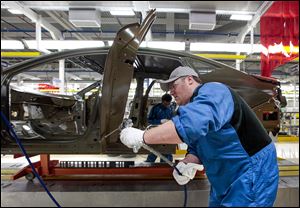
U.S. economy surpasses expectations
4% annual rate of growth for April to June
7/31/2014
An assembly line employee works on a 2015 Chrysler 200 at the Sterling Heights Assembly Plant in Sterling Heights, Mich. The rough winter weather might have contributed to a big increase in spring automobile sales, one economist said, as weather-damaged cars were replaced or repaired.
The U.S. economy rebounded heartily in the spring after a dismal winter, the Commerce Department reported Wednesday, growing at an annual rate of 4 percent from April through June and surpassing economists’ expectations.
In its initial estimate for the second quarter, the government cited a major advance in inventories for private businesses, higher government spending at the state and local level, and personal consumption spending as chief contributors to growth.
Economists, who had been hoping for a full reversal of the first quarter’s decline, were cheered by the second quarter’s numbers. The consensus forecast for GDP was 3 percent.
“Fantastic,” Douglas Handler, chief U.S. economist for IHS Global Insight Analysis, said of the second-quarter GDP increase. The bigger-than-expected gain further cemented views that the decrease in America’s overall output during the first quarter was most likely a fluke tied in large part to unusually stormy winter weather and other anomalies.
Any dip in gross domestic product outside an official recession is considered rare.
During the first quarter, output shrank at a rate of 2.1 percent, less than had been previously reported, according to the Commerce Department’s newly revised GDP figures, also released Wednesday. The department had earlier said first-quarter output decreased 2.9 percent.
The latest numbers prompted a debate among economists looking to the future, some of whom consider the gains as merely corrections for an unusually bleak quarter.
They noted that while inventories improved significantly in the spring and contributed to the rise in GDP, those gains can be extremely volatile. Other economists are more optimistic and see the second-quarter growth as a sign the economy is finally set to shake off the post-recession sluggishness and expand at a healthy clip for the rest of the year. Among those with a sunnier outlook are economists at Barclays, who are forecasting a 2.5 percent growth rate for the second half of 2014.
“It isn’t something people are going to get excited about but it does represent honest, real progress,” said Michael Gapen, a senior economist for Barclays. “It’s not fake.”
Besides inventory increases, other factors fueled second-quarter gains. Consumers spent more money on furniture, recreational goods, and health care.
The bad weather might have contributed to a big increase in automobile sales, one economist speculated, as weather-damaged cars were replaced or repaired. Also, state and local government spending improved markedly.
Gains in housing helped the economy expand but were concentrated in mutli-family construction and were small considering losses in prior quarters.
The Council of Economic Advisers said in a release that the second-quarter gains were strong but that the economy could perform even better if Congress makes sure infrastructure improvements such as work on roads and bridges doesn’t stall this fall.